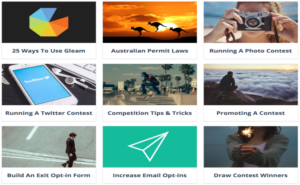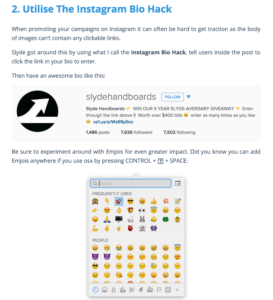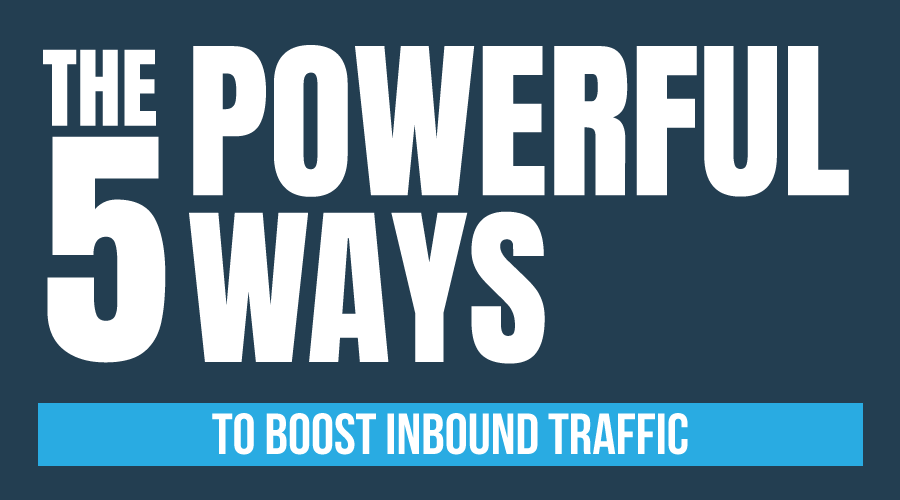Do you want to boost your inbound traffic?
Are you aware that there are tools you can use to attract visitors and customers to your site?
In this article, I will show you 5 powerful tools that will get you that much-needed website traffic.
1. Create Blog Content that Engages Readers
Before you can generate inbound traffic, you’ll need content. One way to this is to create blog posts.
Why blog posts?
Because a 2015-2016 statistics gathered by Hubspot shows:
- Companies that post at least 4 blogs a week get more than 3x traffic compared to non-blogging competitors.
- Almost half of the people surveyed said that they skimmed blog post.
Wow! That’s easy I can do that!
Not so fast.
Make sure that you’re creating a blog post that’s valuable enough for people to read.
How can I create a blog like that?
Good question. Here’s how:
- Create blogs that your target market is interested in.
- Identify their problems or pain points.
- Offer a solution.
- Use relevant keywords for SEO purposes.
- Don’t forget to include a convincing call to action (CTA).


2. Never Underestimate SEO
Now that you’re creating blogs the next step is to promote them. (You can also include your website.) And the most reliable way to do that is via organic SEO.
What is organic SEO?
Techopedia defines it as the use of unpaid (free) and algorithm-driven methods to rank in the search engines.
This means we don’t pay for ads to boost our site. Instead, we use our blog posts to get noticed by the search engines.
Are you sure that organic SEO is more effective than paid ads?
Yes. And I have Search Engine Journal’s data to back it up:
- 7 out of 10 users prefer organic search.
- Almost 8 out of 10 users favor organic results not paid ads.
- Almost all online user start surfing with a search engine.
Take note that optimizing your website and blog is an ongoing process. It involves a lot of work but the result is worth it. Here are the 3 things you can do to optimize your blog or site.
a. Research for keywords and use it in your articles.
You need to use what your potential readers are searching online. Take note:
- Short keywords will attract visitors to your site.
- Long-tail keywords are more successful in converting.
- Keyword stuffing is penalized by search engines like Google.
b. Do on-page SEO.
FYI an on-page refers to both the content and HTML code. How can an on-page SEO increase my inbound traffic?
According to an article by Neil Patel, Google likes and rewards well-optimized pages by increasing the site’s ranking.
How can I improve the SEO of my On-page? There are several ways:
– Title tags are short but descriptive without duplicating the content from your page.
-You need to do the same with Meta descriptions, use only 160 characters or less.
- As mentioned before, blogs not ads are the better and cheaper option to optimize your site.
C. Build Links.
What is link building?
It’s the process of getting other websites to link back to your website. Its purpose is to drive referral traffic to increase your site’s authority.
Links are important if you want to rank in search engines. This is because Google considers blogs or sites with many backlinks as authoritative.
Great! Now how do we build those links?
Well, there’s a right and a wrong way. But will focus on earning links the correct way where you don’t incur Google’s wrath. Here’s what you should do courtesy of WordStream:
- Promote the quality blogs that you have created.
- Use social media to talk about your blog or product.
- You can also contact influencers to help you out.
- Ask friends and colleagues to link to your site.
3. Social Media is Your Friend
You can use social media to distribute your content to a large audience.
Social media includes:
You can also use tools to help you determine if you’re reaching your target market.
For example:
You can use Facebook Audience Insights to:
- Describe your ideal customer or reader
- How to attract them
- How to convert them


4. Don’t Ignore Your Email Campaigns
A lot of online marketers like to use emails for the following reasons:
- High ROI rate. According to McKinsey, you will likely get 40 customers compared to 1 from social media sites
- Marketing Sherpa reports that 7 out of 10 people like to receive product information via email compared to social media.
To make email as an effective tool in your arsenal you need to create:
- an enticing subject line (link)
- an engaging content (link)
5. Share Useful Product Guides and Case Studies
You can also create your own product guide and distribute it via email and social media.
Why would they read a product guide? Isn’t that boring?
Not if they desperately need some information about the product. A Hubspot article proved that product guides can generate inbound traffic.


Courtesy of Hubspot
They run a contest where contestants need to create product guides based on what people are searching for online. The results showed that averages of 50,000 plus people were reading the guide every month.
You see? People still read “boring” product guides.
Case studies are also useful for getting inbound traffic. Just make sure to make the case studies are engaging and not boring. I’m sure you now have an idea of how make case studies that are interesting to read.
Still, I’ll show you how Hubspot does it. They add an item called “Takeaways”. It doesn’t have to be closely related to the product but:
- Has to add value.
- Engage readers and makes it easier to respond to CTAs.

 Courtesy of Hubspot
Courtesy of Hubspot
There you have it. If you use these tools properly, your inbound traffic will rise substantially.
- What Type of Content Is Right for Your Next Product Launch? - November 28, 2018
- 5 Things Bloggers Need To Know About Dealing With Brands - October 31, 2018
- What Is An Editorial Calendar… And Does Your Blog Need One? - August 16, 2018

